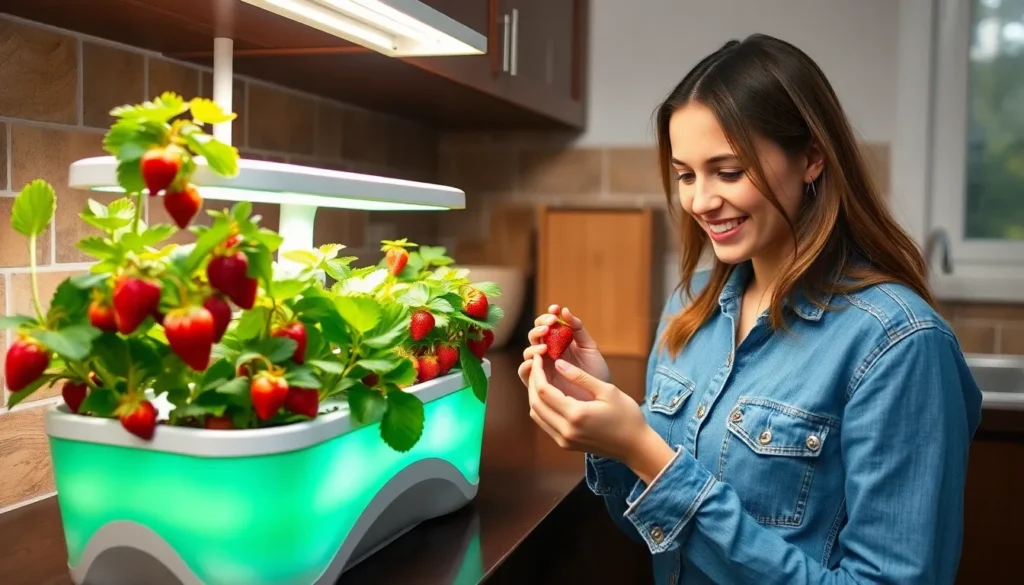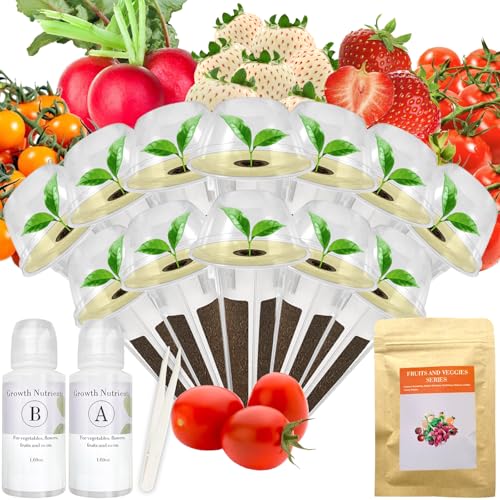Growing strawberries indoors has never been easier thanks to AeroGarden’s innovative hydroponic systems. We’ve discovered that these compact indoor gardens transform any kitchen counter into a year-round strawberry paradise, delivering fresh berries regardless of weather or season.
AeroGarden strawberries offer the perfect solution for gardening enthusiasts who crave homegrown fruit without the hassle of traditional soil-based cultivation. These systems use advanced LED grow lights and nutrient-rich water answers to create optimal growing conditions that produce sweeter, more flavorful berries than many store-bought varieties.
Whether you’re a beginner gardener or an experienced grower, we’ll show you exactly how to maximize your AeroGarden strawberry harvest. From selecting the right varieties to troubleshooting common issues, you’ll learn everything needed to enjoy fresh, pesticide-free strawberries from your own indoor garden within weeks of planting.
Materials and Equipment Needed
AeroGarden systems provide the foundation for growing strawberries indoors. Models like the Harvest Elite, Bounty Elite, and Farm models accommodate different space requirements and strawberry varieties.
Strawberry seed pods designed specifically for AeroGarden systems eliminate guesswork in seed selection. Everbearing varieties such as Alexandria and Seascape produce fruit continuously throughout the growing season.
LED grow lights come pre-installed with most AeroGarden units and deliver full-spectrum illumination. These lights provide 24-40 watts of power depending on your system model.
Liquid nutrients fuel strawberry growth and fruit production. AeroGarden’s liquid fertilizer contains balanced NPK ratios of 4-3-6 plus essential micronutrients.
Growing medium consists of rockwool or coconut coir that supports root development. These materials retain moisture while allowing proper drainage and aeration.
pH testing strips help monitor water acidity levels between 5.5-6.5 for optimal nutrient absorption. Testing kits include color charts for accurate readings.
Water reservoir capacity varies from 1 gallon in compact models to 4 gallons in larger systems. Distilled or filtered water prevents mineral buildup that can affect plant health.
Pruning shears enable precise removal of runners and dead foliage. Sharp, clean blades prevent damage to healthy plant tissue.
Support structures like bamboo stakes or plant clips help strawberry plants maintain upright growth. These accessories prevent stems from breaking under fruit weight.
Timer controls regulate light cycles automatically in most AeroGarden models. Manual timers work as backup options for older systems without built-in programming.
Setting Up Your AeroGarden for Strawberries
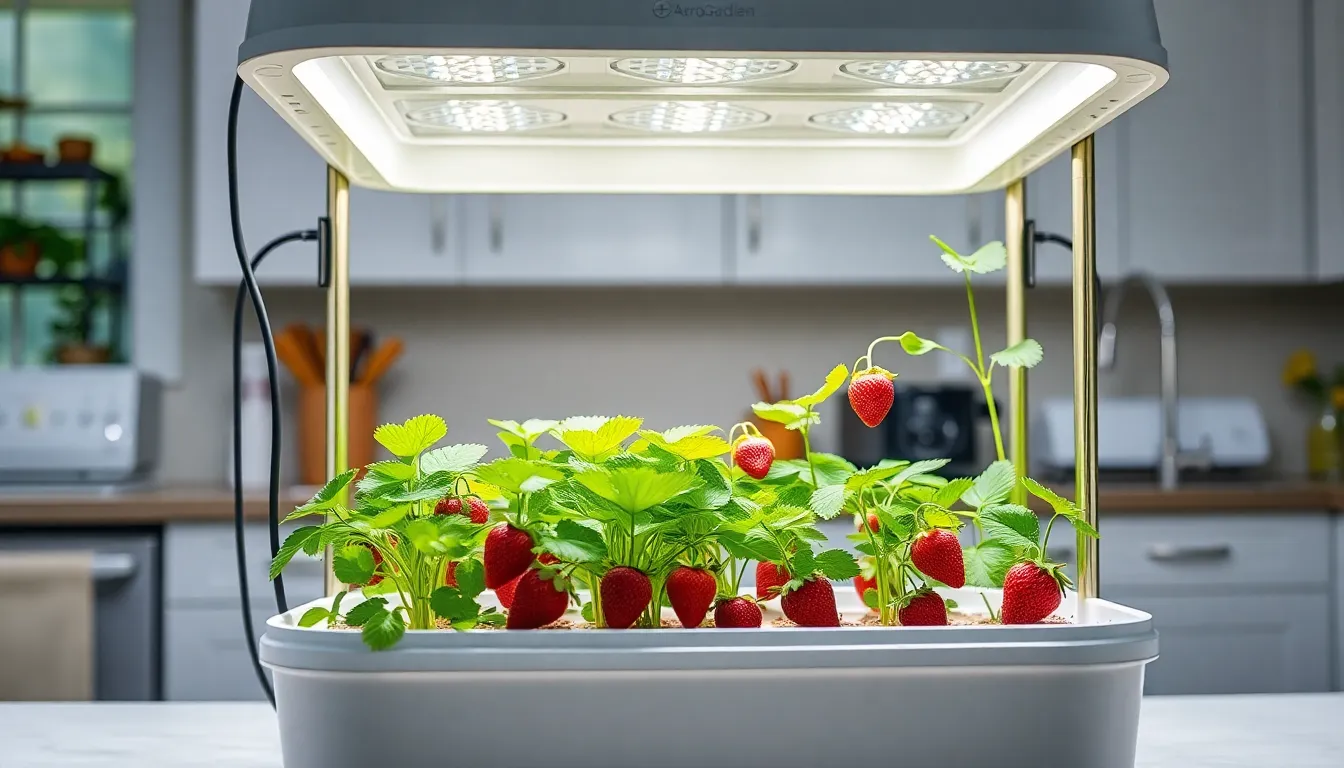
Once you have gathered your materials and equipment, establishing the proper foundation for your strawberry cultivation begins with careful system configuration.
Choosing the Right AeroGarden Model
Bounty and Ultra models provide the optimal growing environment for strawberry cultivation due to their spacious design that accommodates berry plant expansion and fruiting requirements. These models offer sufficient vertical clearance for strawberry plants to develop their characteristic spreading growth pattern.
Farm models deliver maximum growing capacity for households wanting to cultivate multiple strawberry varieties simultaneously. Harvest Elite systems work effectively for compact spaces while still supporting 2-3 strawberry plants with adequate fruit production.
Growing pod capacity varies significantly between models:
| Model | Pod Capacity | Ideal Plant Count | Growing Space |
|---|---|---|---|
| Bounty | 9 pods | 6-7 strawberries | 24 inches height |
| Ultra | 7 pods | 5-6 strawberries | 24 inches height |
| Farm | 24 pods | 18-20 strawberries | 36 inches height |
Assembling Your AeroGarden System
Initial setup requires precise component alignment according to manufacturer specifications to ensure proper water circulation and plant support. Water reservoir installation forms the foundation of your hydroponic strawberry system.
Pump assembly connects directly to the reservoir base using the provided tubing and fittings. Nutrient delivery tubes must reach each growing pod position without kinks or restrictions that could impair water flow.
Growing deck placement requires firm seating on the reservoir rim to prevent water leakage during operation. Pod baskets insert into growing deck holes with gentle pressure until they sit flush with the deck surface.
Control panel mounting secures to the back of the water reservoir using the integrated bracket system. Power cord positioning allows easy access to electrical outlets without creating trip hazards in your growing area.
Installing the Grow Light
Grow lights maintain 2-4 inches distance from plant tops to prevent leaf burning while delivering adequate photosynthetic energy for strawberry development. Light positioning adjusts as plants grow taller throughout their cultivation cycle.
Height adjustment mechanisms on AeroGarden models use simple post extension systems that accommodate strawberry plant growth up to 24 inches. Weekly height monitoring ensures consistent light exposure as your strawberry plants develop their canopy structure.
Light cycle programming follows strawberry-exact schedules that provide 16 hours of illumination daily during vegetative growth phases. Fruiting phase adjustments may require extended lighting periods to support flower development and berry production.
LED panel installation involves sliding the light fixture onto the support posts until secure connection occurs. Timer controls activate automatically once you plug the system into standard household electrical outlets.
Selecting and Planting Strawberry Seeds
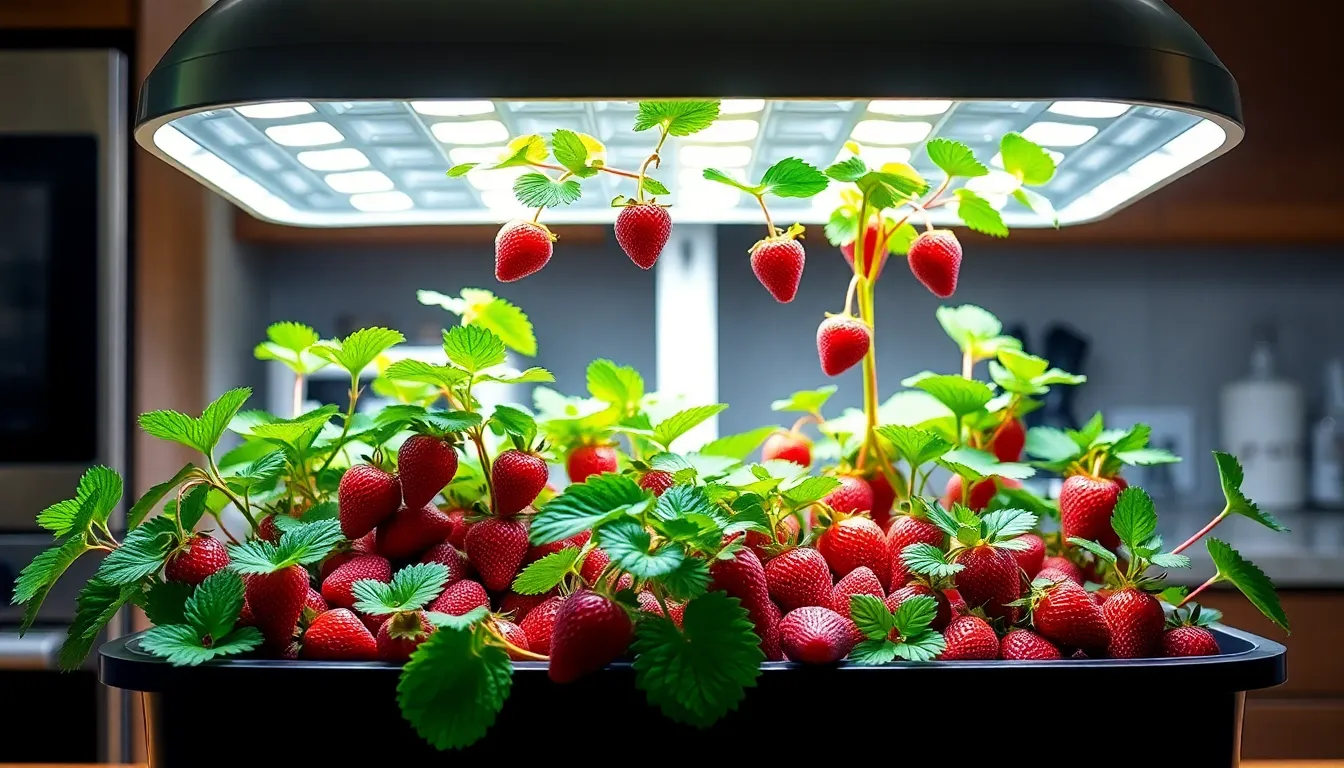
Successful strawberry cultivation in your AeroGarden begins with choosing the right varieties and proper seed handling techniques. Strategic selection and preparation maximize germination rates and ensure robust plant development.
Best Strawberry Varieties for AeroGarden
Seascape and Alexandria Everbearing varieties deliver optimal performance in AeroGarden hydroponic systems. Seascape strawberries produce compact plants that adapt well to limited growing space while maintaining continuous fruit production cycles. Alexandria Everbearing cultivars offer similar space efficiency with extended harvesting periods throughout the growing season.
Both varieties demonstrate superior tolerance to indoor growing conditions compared to traditional garden strawberry types. Compact growth patterns prevent overcrowding in AeroGarden pods while maximizing fruit yield potential. Everbearing characteristics ensure steady strawberry production rather than single seasonal harvests.
Preparing the Seed Pods
AeroGarden seed pods require proper moisture levels and nutrient availability before strawberry seed insertion. Pre-moistening pods with distilled water creates optimal germination conditions without introducing harmful chemicals or minerals. Specialized AeroGarden nutrients provide essential macro and micronutrients designed specifically for hydroponic strawberry cultivation.
Pod preparation involves gentle saturation without oversaturation that could lead to seed rot. Balanced moisture retention allows seeds access to necessary hydration while maintaining adequate air circulation. Nutrient distribution throughout the growing medium ensures immediate access to fertilization once germination begins.
Planting Your Strawberry Seeds
Starting seeds in separate growing medium before transferring to AeroGarden pods significantly improves germination success rates compared to direct seeding methods. Place 2-3 strawberry seeds in small containers filled with seed starting mix and cover with clear plastic wrap to maintain consistent humidity levels.
Position seed containers under grow lights maintaining temperatures between 65-75°F for optimal germination conditions. Monitor seedlings for 7-14 days until robust root systems and true leaves develop. Transfer established seedlings to prepared AeroGarden pods once plants reach 2-3 inches in height.
Adjust grow light positioning to maintain 2-4 inches distance above plant tops as strawberry seedlings establish in the hydroponic system. Regular monitoring ensures proper light exposure without causing heat stress to developing plants.
Optimal Growing Conditions for AeroGarden Strawberries
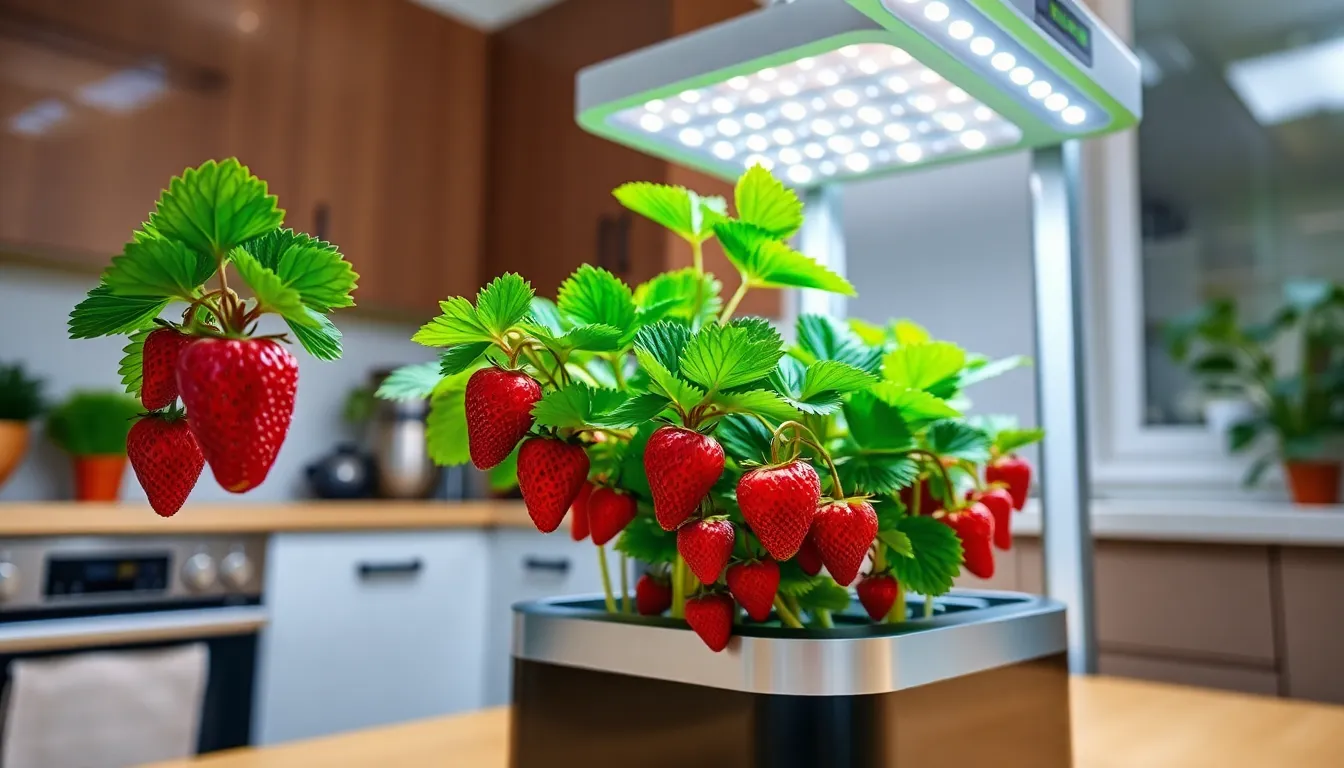
Creating the perfect environment for AeroGarden strawberries requires balancing light, water, and nutrients for maximum fruit production. Temperature stability between 65°F to 75°F (18°C to 24°C) maintains consistent growth throughout the growing cycle.
Setting the Correct Light Schedule
Strawberry plants require 12 to 16 hours of daily light to simulate extended summer conditions and promote continuous flowering. Extended light periods trigger the photosynthesis process that produces the energy needed for fruit development.
Program the AeroGarden timer to provide consistent illumination during these extended periods. Built-in LED systems deliver the optimal spectrum without requiring manual adjustments throughout most of the growth cycle.
Maintain grow lights 4 to 6 inches above the plants as they develop to prevent light burn while ensuring adequate coverage. Distance adjustments become critical as strawberry plants reach their mature height and spread horizontally.
Monitor plant response to light exposure and reduce duration if leaves show signs of stress or yellowing. Light intensity adjustments through the AeroGarden controls fine-tune the growing environment based on seasonal variations.
Maintaining Proper Water Levels
Water levels must remain consistently topped up to ensure roots maintain contact with the nutrient solution at all times. Root exposure to air for extended periods causes stress and reduces fruit production capacity.
Check water levels every 2-3 days during active growing periods when plants consume water rapidly. Visual indicators on most AeroGarden models alert you when reservoir levels drop below optimal ranges.
Replace the entire water reservoir every two weeks to prevent bacterial buildup that can damage root systems. Fresh water changes maintain dissolved oxygen levels that strawberry roots require for healthy development.
Clean the water reservoir thoroughly during each change using mild soap and warm water. Residue removal prevents algae growth and maintains the sterile environment necessary for hydroponic success.
Adding Nutrients at the Right Time
Apply the recommended nutrient mix that comes standard with AeroGarden systems or equivalent hydroponic answers designed for fruiting plants. Balanced NPK ratios support both vegetative growth and fruit development phases.
Add nutrients during each water change to maintain consistent feeding throughout the growing cycle. Fresh nutrient answers provide the essential minerals strawberry plants extract from the water as they grow.
Monitor plant response and adjust nutrient concentrations based on leaf color and fruit production rates. Yellowing leaves often indicate nutrient deficiency while dark green foliage may signal over-fertilization.
Test pH levels weekly to ensure they remain between 5.5 and 6.5 for optimal nutrient uptake. pH adjustments using hydroponic pH answers correct imbalances that prevent proper mineral absorption.
Daily and Weekly Care Routine
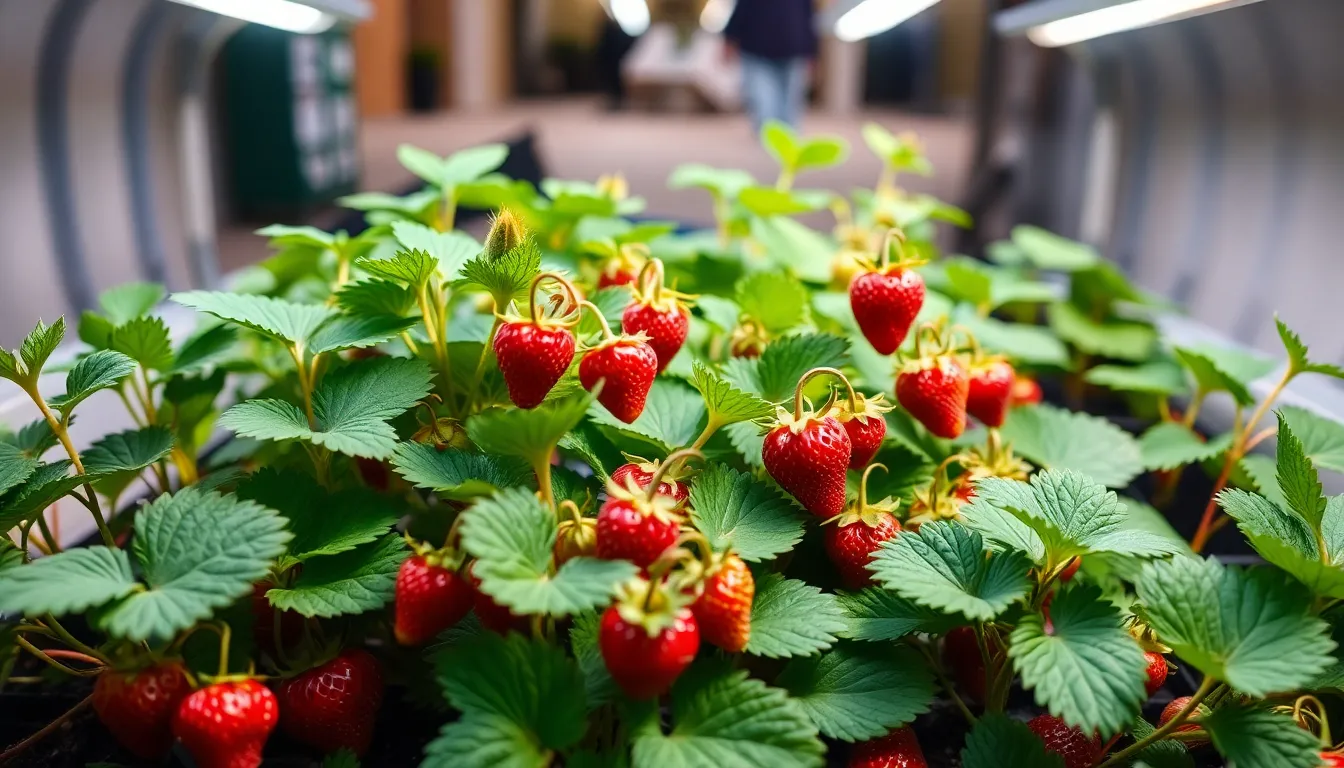
Establishing consistent daily and weekly care patterns ensures robust strawberry production in your AeroGarden system. Regular monitoring prevents problems before they impact fruit quality and yield.
Monitoring Plant Growth
Daily plant growth monitoring reveals critical changes that determine harvest success. Check for new leaves, flowers, and developing fruit each morning to track development patterns. Height management requires maintaining grow lights 2-4 inches above plant tops to promote healthy growth without burning foliage.
Watch for runners appearing on mature plants as these structures divert energy from fruit production. Runner development signals the plant’s reproductive stage but reduces berry size and quantity. Temperature fluctuations between 65°F to 75°F indicate optimal growing conditions for consistent growth rates.
Document flowering patterns to predict harvest timing since strawberry plants produce fruit 4-6 weeks after initial flowering. New leaf emergence every 2-3 days indicates healthy nutrient uptake and proper environmental conditions.
Pruning and Training Strawberry Plants
Strategic pruning concentrates plant energy into fruit production rather than excessive foliage growth. Remove runners immediately upon appearance to prevent energy redirection from berry development. Cut runners at their base using clean pruning shears to avoid plant damage.
Prune dead leaves weekly by removing brown or yellowing foliage at the stem base to prevent disease spread. Flower pruning requires selective removal where pinching some flowers promotes plant growth and increases berry size while leaving others ensures continuous fruiting cycles.
Training involves gentle repositioning of stems to maximize light exposure across all plant sections. Support heavy fruit clusters using small plant stakes to prevent stem breakage during berry development. Never remove more than 1/3 of plant material during any single pruning session to avoid shocking the plant.
Checking Water and Nutrient Levels
Water level maintenance requires daily visual inspection and weekly complete monitoring. Top off water reservoirs when levels drop below the minimum indicator to maintain consistent nutrient delivery. Fresh water additions every 2-3 days compensate for plant uptake and evaporation losses.
Weekly nutrient management involves adding 1ml of balanced fertilizer like Fox Farm Grow Big until plants develop 5-6 true leaf sets. Increase nutrient concentration to 1.5ml every other day once plants enter active flowering and fruiting phases.
| Growth Stage | Nutrient Amount | Frequency |
|---|---|---|
| Seedling (1-4 weeks) | 1ml Fox Farm Grow Big | Weekly |
| Mature Plant (5+ weeks) | 1.5ml Fox Farm Grow Big | Every other day |
| Flowering/Fruiting | 1.5ml Fox Farm Grow Big | Every other day |
Replace entire water reservoir contents bi-weekly to prevent bacterial buildup and maintain optimal pH levels between 5.5-6.5. Test pH weekly using digital meters to ensure proper nutrient absorption rates.
Pollinating Your Indoor Strawberry Plants
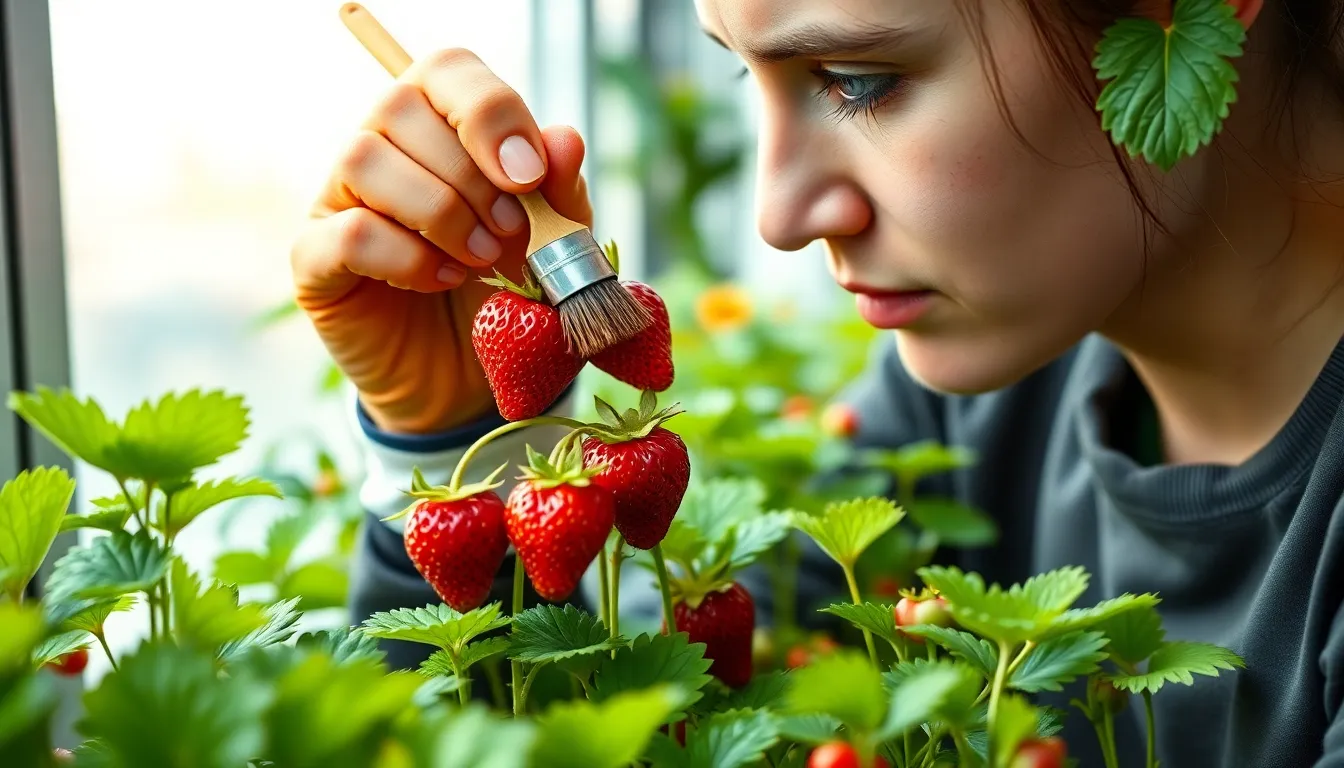
Indoor strawberry cultivation requires manual intervention to achieve the pollination that naturally occurs outdoors through insects and wind.
Understanding Strawberry Pollination
Strawberries are self-pollinating plants, meaning each flower contains both male and female reproductive parts. The absence of natural pollinators like bees in indoor environments makes hand pollination essential for optimal fruit development. Effective pollination ensures that pollen transfers from the anthers to the stigma within each flower, resulting in better berry formation and larger harvests.
Indoor strawberry flowers benefit significantly from manual pollination assistance even though their self-pollinating nature. We observe improved fruit set rates when we actively participate in the pollination process rather than relying solely on the plant’s natural mechanisms.
Hand Pollination Techniques
Gentle hand pollination mimics the natural transfer of pollen that insects would typically perform outdoors. Start the pollination process when flowers fully open and display visible yellow centers with prominent anthers and stigmas.
Transfer pollen by moving from flower to flower systematically across your AeroGarden strawberry plants. Touch each flower’s center gently to collect pollen on your chosen tool, then immediately apply this pollen to the stigma of the same or different flowers.
Perform pollination activities during mid-morning hours when pollen production reaches peak levels. Repeat this process every 2-3 days while flowers remain open and receptive to maximize fertilization success rates.
Using a Small Brush for Pollination
A small, soft-bristled brush serves as the most effective tool for transferring pollen between strawberry flower parts. Select brushes with natural bristles approximately 1/4 inch in length to ensure gentle contact with delicate flower structures.
Brush the yellow anthers first to collect pollen grains on the bristles, creating a visible coating of fine powder. Move the loaded brush immediately to the stigma (the sticky center part) of the same flower, making light circular motions to deposit the collected pollen.
Clean the brush between different plants by gently tapping it against a clean surface to remove excess pollen buildup. Store the pollination brush in a dry location between use sessions to maintain bristle integrity and prevent contamination.
Alternative tools include cotton swabs or small makeup brushes when dedicated pollination brushes are unavailable. We find that softer bristles produce better results than synthetic alternatives, as they pick up and release pollen more effectively without damaging flower tissues.
Harvesting Your AeroGarden Strawberries
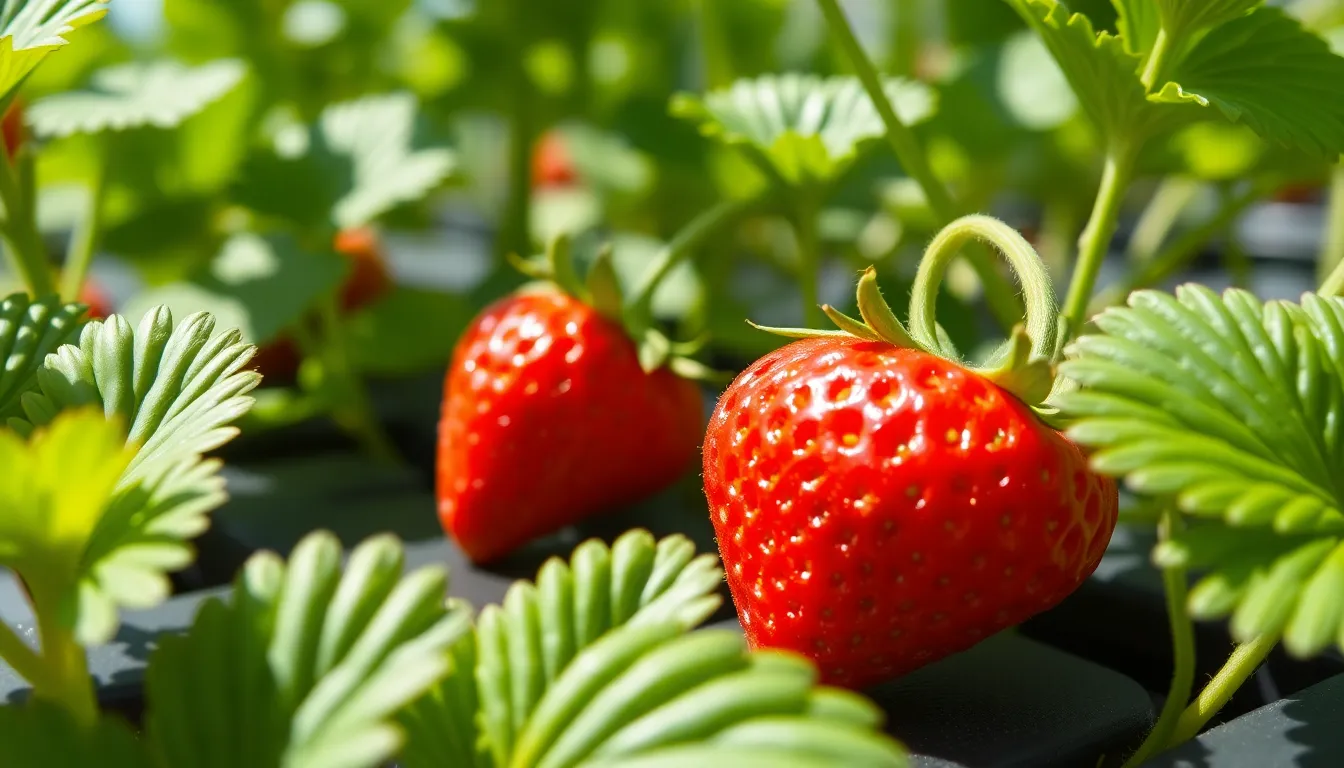
After weeks of careful cultivation and pollination, your AeroGarden strawberries reach maturity and become ready for harvest. Timing the harvest correctly maximizes flavor and encourages continued fruit production.
Identifying Ripe Strawberries
Bright red color and slight softness indicate that AeroGarden strawberries have reached optimal ripeness. Color transformation occurs gradually as the fruit matures from white to pink to deep red over several days. Touch reveals the perfect harvesting moment when strawberries yield gently to light pressure without feeling mushy or overly firm.
Variety determines the exact ripeness timeline, with most AeroGarden strawberries reaching maturity 60 to 90 days after planting. Alexandria Everbearing strawberries typically show readiness at the shorter end of this range, while Seascape varieties may require the full 90 days depending on growing conditions. Size varies by variety, but ripe strawberries generally measure 1 to 2 inches in diameter when fully developed.
Proper Harvesting Techniques
Morning harvesting produces the most flavorful strawberries when plants contain peak sugar content after overnight recovery. Temperature remains cooler during morning hours, preserving fruit quality and extending shelf life after harvest.
Gentle twisting motions remove strawberries from plants without damaging stems or surrounding fruit. Grip the strawberry near the stem and rotate clockwise while pulling upward to separate the fruit cleanly. Avoid tugging or yanking motions that stress the plant and potentially harm developing flowers or young fruit.
Regular harvesting every 2 to 3 days encourages continuous fruit production throughout the growing season. Frequent collection prevents overripe fruit from remaining on plants, which can attract pests or develop mold. Plants redirect energy toward new flower and fruit development when mature strawberries are removed promptly.
Storage Tips for Fresh Strawberries
Cool, dry storage maintains strawberry freshness for 3 to 5 days after harvest. Room temperature storage works for same-day consumption, but refrigeration extends usable life significantly. Store strawberries in breathable containers that allow air circulation while preventing moisture buildup.
Refrigerated strawberries remain fresh for several days to one week when stored properly in the main compartment at 32°F to 35°F (0°C to 2°C). Place unwashed strawberries in shallow containers lined with paper towels to absorb excess moisture. Avoid washing strawberries before storage since excess moisture accelerates spoilage and reduces shelf life.
Container selection affects storage success, with perforated plastic containers or paper cartons providing optimal air circulation. Stack strawberries no more than two layers deep to prevent crushing bottom fruit. Check stored strawberries daily and remove any showing signs of decay to prevent spread to healthy fruit.
Troubleshooting Common Issues
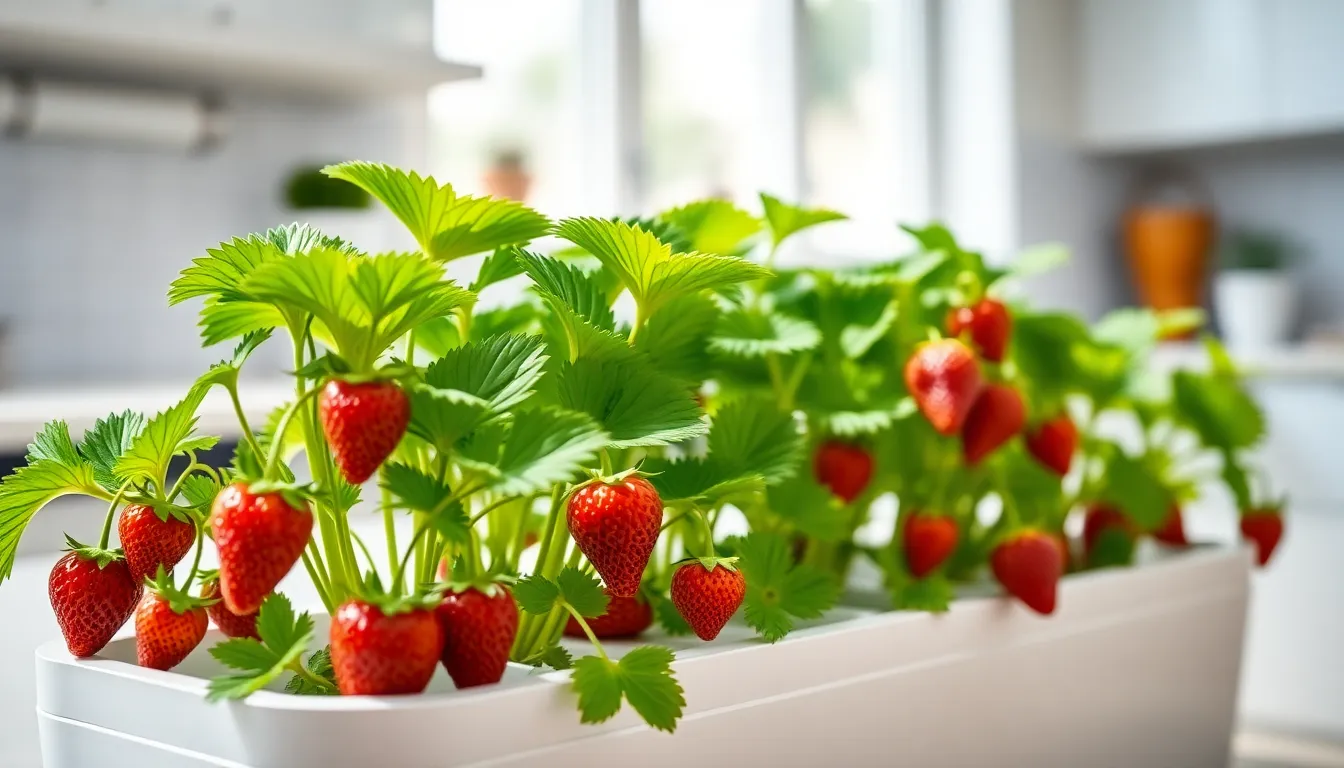
Growing strawberries in your AeroGarden system occasionally presents challenges that require quick identification and resolution. Recognizing symptoms early prevents minor issues from becoming major problems that affect your harvest.
Yellowing or Brown Leaves
Nutrient imbalances or deficiencies cause yellowing or browning leaves on strawberry plants in AeroGarden systems. Monitor your nutrient solution strength and pH levels when leaf discoloration appears. Over-feeding or under-feeding creates these symptoms along with incorrect pH levels that prevent proper nutrient absorption.
Check your plant roots for waterlogging or signs of rot decay. Root rot leads to yellow and brown leaves as the damaged root system cannot transport nutrients effectively. Replace your nutrient solution every 2 weeks to maintain optimal growing conditions.
Inspect roots regularly for black or mushy sections that indicate root rot. Maintain good water oxygenation by ensuring your AeroGarden pump operates correctly. Remove any affected roots with sterile scissors to prevent further damage.
Poor Fruit Production
Insufficient pollination, light, or nutrients result in poor fruit production in AeroGarden strawberry plants. Transfer pollen manually from flower to flower using a small brush or your finger tip. Complete this pollination process gently during morning hours when flowers are fully open.
Position grow lights 2-4 inches above plant tops as they continue growing. Keep lights on for 14-16 hours daily to support fruit development throughout the growing season. Use recommended hydroponic nutrients according to your plant growth stage.
Prune excess runners and flowers to focus plant energy on fruit production. Remove runners that drain energy from fruit development. Concentrate plant resources by limiting the number of flowering stems to 3-4 per plant.
Algae Growth Problems
Light penetration into the reservoir causes algae growth on grow sponges and in water systems. Cover exposed areas around your AeroGarden pods with aluminum foil or light-blocking materials. Clean your reservoir thoroughly during bi-weekly water changes.
Avoid overfilling water pods that can create standing water on surfaces. Keep your grow deck clean and dry to prevent algae establishment. Block light exposure to water surfaces by ensuring proper pod placement and covering.
Check your system weekly for early algae signs like green film or odors. Remove algae immediately when detected using a clean cloth and mild cleaning solution. Replace affected grow sponges if algae contamination is severe.
Pest Management
Indoor hydroponic systems provide protection from most pests but occasional aphids, spider mites, or fungus gnats may appear. Inspect plants weekly for pest signs including sticky residue, webbing, or small flying insects around your AeroGarden.
Use yellow sticky traps near your system to catch fungus gnats before they establish populations. Apply organic insecticidal soap or neem oil spray for aphids and spider mites when infestations occur. Spray affected areas during evening hours to prevent leaf burn.
Maintain good sanitation by removing dead plant material promptly. Clean growing areas regularly to eliminate pest breeding sites. Remove affected plant parts immediately when pest damage is detected to prevent spread to healthy plants.
Maintaining Your AeroGarden System
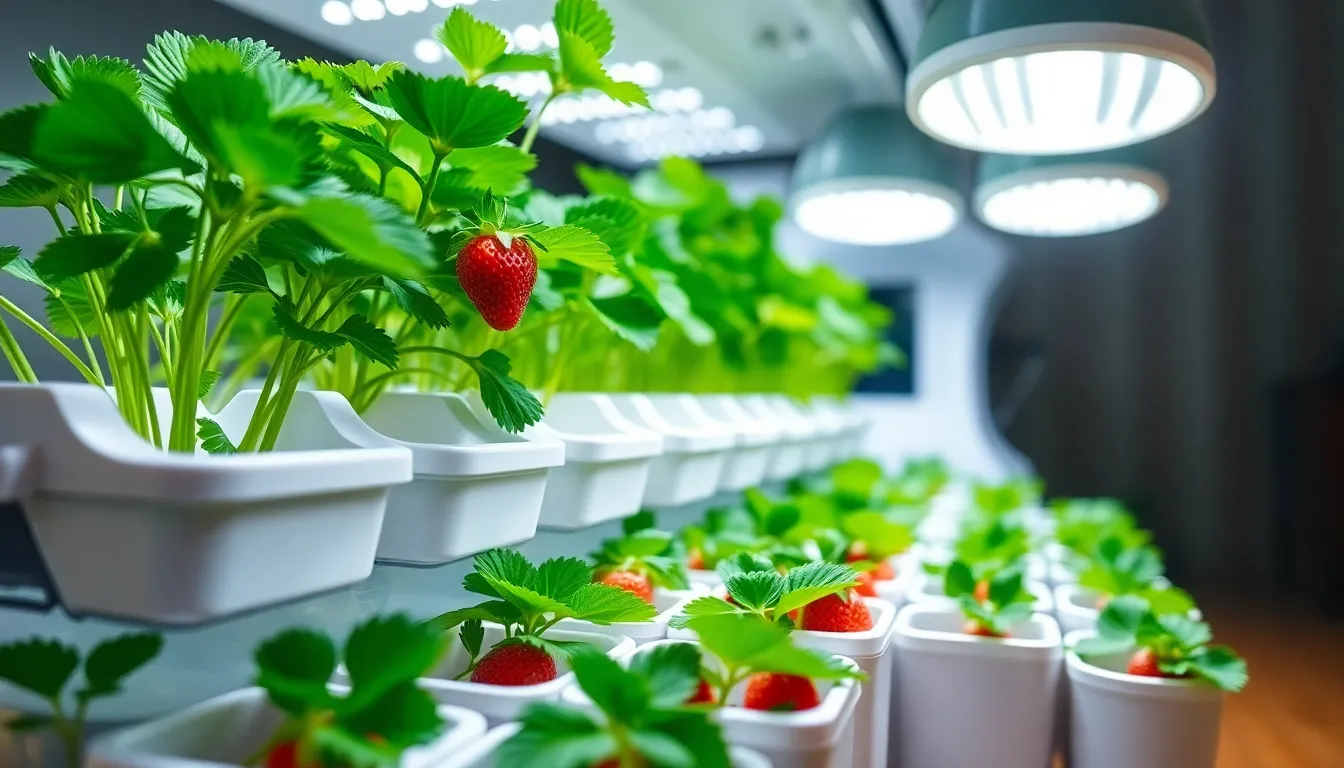
Proper maintenance extends the life of your AeroGarden strawberry system and ensures consistent harvests. Regular cleaning and nutrient management maximize plant health and fruit production.
Cleaning Between Growing Cycles
Remove all plant material from the growing pods before beginning the cleaning process. Dead roots and old plant matter create breeding grounds for bacteria and fungi that damage future crops.
Wash each pod thoroughly with warm water to eliminate debris and nutrient buildup. Scrub the pod surfaces gently with a soft brush to remove stubborn residue without damaging the pod structure.
Clean the water reservoir by emptying all contents and rinsing with fresh water. Wipe down interior surfaces with a damp cloth to remove algae deposits and mineral accumulations.
Inspect the pump and water lines for blockages or algae growth. Clear any obstructions using a pipe cleaner or small brush to maintain proper water circulation.
Replacing Old Nutrients
Use fresh AeroGarden nutrients exclusively as they contain the exact formulation required for hydroponic strawberry growth. Generic hydroponic nutrients lack the precise nutrient ratios that strawberries need for optimal fruit development.
Replace nutrient answers every 2 weeks during active growing periods to prevent nutrient depletion and salt buildup. Old nutrients lose potency and create imbalanced growing conditions that reduce strawberry quality.
Measure nutrients according to package directions based on your exact AeroGarden model capacity. Overfertilization burns roots while underfertilization stunts growth and reduces berry production.
Test pH levels weekly when adding fresh nutrients to ensure readings stay between 5.5 and 6.5 for optimal nutrient uptake. Adjust pH using appropriate answers if readings fall outside this range.
System Reset and Preparation
Reset the AeroGarden system by unplugging the unit for 30 seconds before starting a new growing cycle. This process clears the timer settings and prepares the system for fresh programming.
Fill the reservoir with distilled water up to the fill line marked on your exact model. Tap water contains chlorine and minerals that interfere with nutrient absorption and plant health.
Program new light cycles based on your strawberry variety requirements and growth stage. Everbearing varieties like Alexandria and Seascape perform best with 14 to 16 hours of daily light exposure.
Install fresh seed pods or prepared seedlings into clean growing positions. Bounty and Ultra Units accommodate larger strawberry plants due to their increased growing space and height capacity.
Position grow lights 2 to 4 inches above the newly planted materials to provide adequate illumination without causing heat stress. Adjust light height as plants grow to maintain this optimal distance throughout the growing cycle.
Tips for Maximum Strawberry Yield
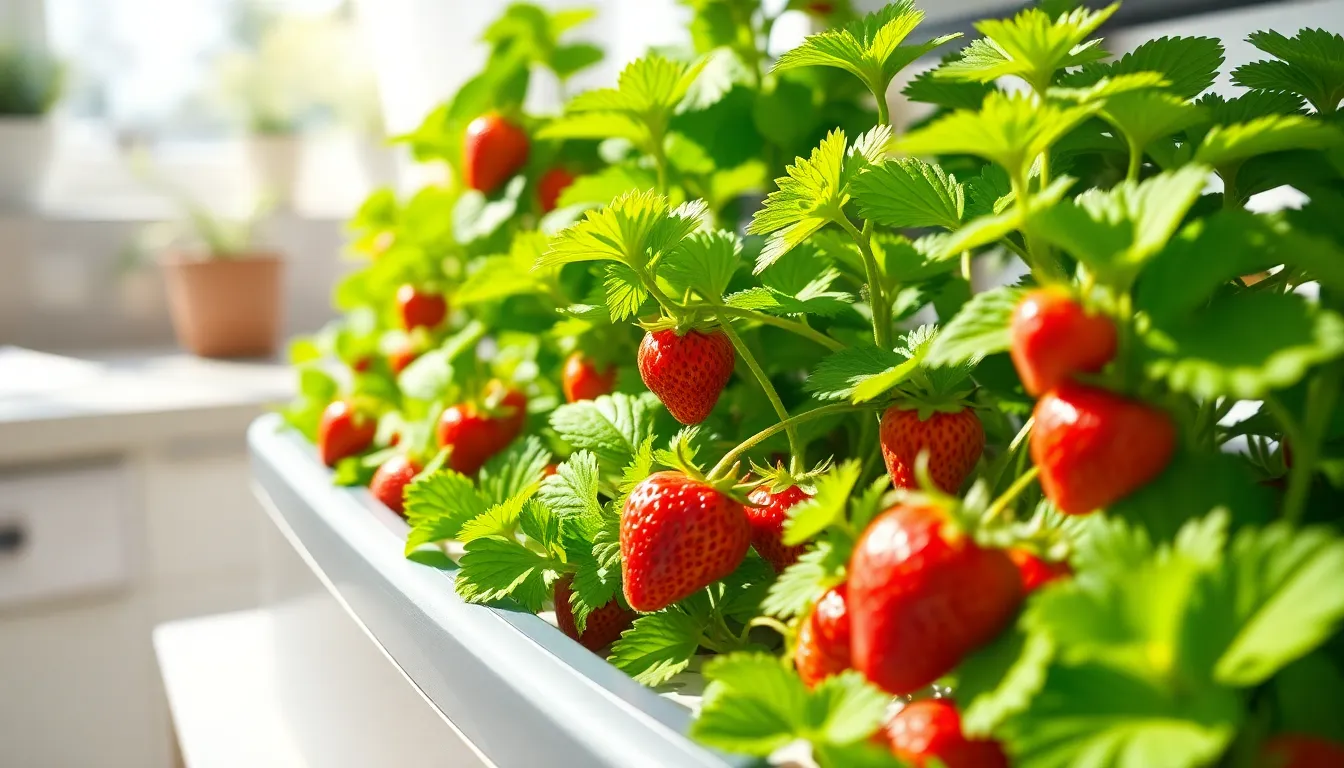
Nutrient optimization and environmental control form the foundation of successful AeroGarden strawberry production. Fox Farm Grow Big delivers superior results compared to standard AeroGarden nutrients when applied at 1ml weekly until plants develop 5-6 true leaves, then increased to 1.5ml every other day.
Extending the Growing Season
Indoor AeroGarden cultivation eliminates seasonal limitations and provides year-round strawberry production. Climate control becomes essential for maintaining consistent temperatures between 65°F to 75°F throughout winter months when outdoor conditions fluctuate dramatically.
Light seasonal adjustment requires modifying grow light schedules to match natural daylight patterns. During winter months, extend lighting periods to 14-16 hours daily to compensate for reduced natural sunlight. Summer cultivation benefits from 12-14 hour cycles that mirror outdoor growing conditions.
Temperature consistency prevents flowering disruption and maintains steady fruit development. Monitor indoor humidity levels to prevent fungal issues that commonly occur during extended growing periods. Position AeroGarden units away from heating vents and air conditioning units that create temperature fluctuations.
Succession Planting Strategies
Staggered planting every 3-4 weeks maintains continuous strawberry production throughout the growing season. AeroGarden Grow Bowls help efficient succession planting by allowing multiple growing cycles in compact spaces.
Planning rotation schedules requires tracking flowering and fruiting phases of existing plants. Start new seed pods when current plants reach peak production to ensure seamless transitions between harvests. Document planting dates and variety performance to optimize future succession timing.
Multiple AeroGarden units enable overlapping growing cycles without disrupting established plants. Dedicate one unit to seedling development while mature plants occupy primary growing positions. Larger models like Bounty or Ultra accommodate staggered plantings within single systems through strategic pod placement.
Companion Planting Options
Compatible herbs like basil and mint enhance strawberry growing environments by repelling common pests without competing for essential nutrients. These aromatic plants create natural pest barriers while maximizing AeroGarden space utilization.
Basil placement in corner pods provides optimal spacing and allows strawberry plants to occupy central growing positions. Mint requires contained growing to prevent root system interference with strawberry development. Both herbs share similar nutrient requirements and light schedules with strawberry plants.
Avoid leafy greens that compete directly for nitrogen and phosphorus resources. Plants like lettuce and spinach deplete nutrients rapidly and create resource competition that reduces strawberry yields. Focus companion selections on plants that complement rather than compete with strawberry nutritional demands.
Conclusion
Growing strawberries in your AeroGarden transforms your kitchen into a year-round fruit paradise. We’ve shown you how these hydroponic systems deliver sweeter berries faster than traditional gardening while eliminating weather worries and pest problems.
Your success depends on consistent care routines and attention to detail. From proper pollination techniques to optimal nutrient timing we’ve covered every aspect needed for thriving indoor strawberry plants.
The investment in an AeroGarden system pays dividends through continuous harvests of fresh pesticide-free strawberries. With our comprehensive guide you’re equipped to enjoy homegrown berries within weeks regardless of the season outside your window.
Frequently Asked Questions
Can I really grow strawberries indoors year-round with AeroGarden?
Yes, AeroGarden’s hydroponic systems allow you to grow strawberries indoors throughout the year. The LED grow lights and nutrient-rich water system create optimal growing conditions regardless of outdoor weather, enabling continuous cultivation on your kitchen counter.
What AeroGarden models work best for growing strawberries?
The Bounty Elite and Ultra models are ideal due to their spacious design, while the Farm model offers maximum capacity. The Harvest Elite works for smaller spaces but may limit plant growth. Choose based on your available space and desired strawberry quantity.
Which strawberry varieties grow best in AeroGarden systems?
Everbearing varieties like Alexandria and Seascape thrive in AeroGarden systems. These compact varieties are specifically suited for hydroponic growing and provide continuous fruit production, making them perfect for indoor cultivation.
How often should I change the water and add nutrients?
Replace the water reservoir every two weeks to prevent bacterial buildup. Check water levels every 2-3 days and add nutrients according to your plant’s growth stage – typically weekly during active growing periods.
Do I need to pollinate strawberry flowers manually indoors?
Yes, indoor strawberries require manual pollination since there are no natural pollinators. Use a small brush to gently transfer pollen between flowers during morning hours when pollen is most viable for best results.
What temperature and lighting conditions do strawberries need?
Maintain temperatures between 65°F to 75°F (18°C to 24°C) with 12-16 hours of daily light. Keep grow lights 2-4 inches above plants and adjust height as they grow to prevent burning or stretching.
How long does it take to harvest strawberries from AeroGarden?
You can expect to harvest fresh strawberries in just a few weeks after flowering begins. With proper care and everbearing varieties, plants will continue producing fruit for several months, providing ongoing harvests.
What maintenance tasks are required for healthy strawberry plants?
Daily tasks include monitoring water levels and plant growth. Weekly tasks involve checking pH levels, adjusting nutrients, pruning dead leaves and runners, and ensuring proper light positioning for optimal fruit production.

